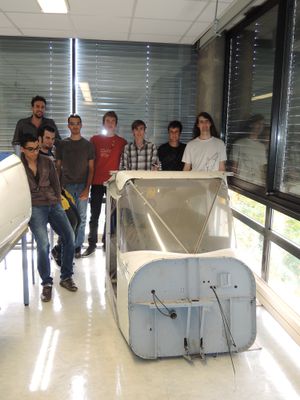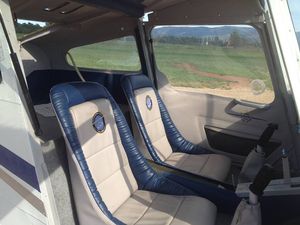Difference between revisions of "Projets-2016-2017-StartAir"
| (8 intermediate revisions by 2 users not shown) | |||
| Line 1: | Line 1: | ||
| + | [[Image:StartAIR-ArriveeAPolytech.jpg|300px|thumb|right|Arrivée de la carling StartAIR @ Polytech Grenoble]] |
||
| + | [[Image:StartAIR-Carling1.jpg|300px|thumb|right|Carling de StartAIR]] |
||
| + | [[Image:StartAIR-Carling2.jpg|300px|thumb|right|Carling de StartAIR]] |
||
| + | [[Image:StartAIR-Carling3.jpg|300px|thumb|right|Carling de StartAIR]] |
||
= The project = |
= The project = |
||
[[StartAIR 2017]] : For a few decades, disabled accessibility to every structures and activities has been a major concern. Yet, they are still excluded from many fields, aeronautics is one of them. The association Start'Air Initiative has for project to allow autistic people, especially Aspergers, to feel the sensation of driving a plane. For some years, Polytech Grenoble students have been trying to develop a flight simulator suitable for Aspergers to answer this issue. Many technologies are involved within the simulator to suit the needs of Aspergers. |
[[StartAIR 2017]] : For a few decades, disabled accessibility to every structures and activities has been a major concern. Yet, they are still excluded from many fields, aeronautics is one of them. The association Start'Air Initiative has for project to allow autistic people, especially Aspergers, to feel the sensation of driving a plane. For some years, Polytech Grenoble students have been trying to develop a flight simulator suitable for Aspergers to answer this issue. Many technologies are involved within the simulator to suit the needs of Aspergers. |
||
| + | |||
| + | In order to transmit all the feel of a real flight and to study the behavior of an autist in a situation similar to a flight while staying safe on the ground is essential to create a realistic simulator. The safe Start'air association has managed to recover a real airframe. The main goal of Start’air safe project is to transform it to a computerized simulator. At the end, we must have the impression of being in a real plane. To do it we have to make all the instruments of the airframe functional but also create a virtual environment around with screens. All must be fully managed by a flight simulation software: Flight Simulator X. |
||
| + | |||
The project entrusted to the RICM4 in 2017 is |
The project entrusted to the RICM4 in 2017 is |
||
| − | + | *The realization of a tablet / mobile interface of the ULM dashboard (digital instrumentation), |
|
| − | + | *The reliability of the multi-screen reflector of the Flight Simulator flight simulator. |
|
| + | |||
| + | For item 1: |
||
| + | |||
| + | A first mockup will be based on Grafana with an information production with MQTT. |
||
| + | The project will be carried out by means of Apache Cordova and Meteor |
||
| + | |||
| + | For item 2: |
||
| + | |||
| + | It is to document the installation and configuration of the reflector realized by William BOBO and Corentin RICOU in 2014 (Depot Github). It is not forbidden to contact them. |
||
= Team = |
= Team = |
||
| Line 20: | Line 36: | ||
== Week 1 (9 January - 15 January) == |
== Week 1 (9 January - 15 January) == |
||
| − | * Choice and discovery |
+ | * Choice and discovery the project. |
* Briefing on the tasks to be accomplished and the objectives to be achieved. |
* Briefing on the tasks to be accomplished and the objectives to be achieved. |
||
* Material distribution. Flight Simulator. |
* Material distribution. Flight Simulator. |
||
== Week 2 (16 January - 22 January) == |
== Week 2 (16 January - 22 January) == |
||
| − | |||
| − | * Definition of project requirements. |
||
| − | * Discovery of the work of our predecessor |
||
== Week 3 (23 January - 29 January) == |
== Week 3 (23 January - 29 January) == |
||
| + | |||
| + | *Presentation, the UML and our project in the project room |
||
| + | |||
| + | == Week 4 (30 January - 5 February) == |
||
| + | |||
| + | *Research of documentation |
||
| + | *Discover technologies associate of the project Meteor, Cordova, Grafana, MQTT. |
||
| + | |||
| + | == Week 5 (6 February - 12 February) == |
||
| + | |||
| + | *Attempt to contact old students in the aim best understanding |
||
| + | *Auto formation on technologies |
||
| + | *Meeting with other option to be according on the tasks |
||
| + | |||
| + | == Week 6 (13 February - 19 February) == |
||
| + | |||
| + | *Getting started |
||
| + | *Create project |
||
| + | |||
| + | == Week 7 (20 February - 26 February) == |
||
| + | |||
| + | *Holidays |
||
| + | |||
| + | == Week 8 (27 February - 5 March) == |
||
| + | |||
| + | *redefinition of pact with the global tutor (maps) |
||
| + | *including the new pact in project |
||
| + | |||
| + | == Week 8 (6 March - 12 March) == |
||
| + | |||
| + | |||
| + | |||
| + | |||
| + | == Week 8 (13 March - 19 March) == |
||
| + | |||
| + | |||
| + | |||
| + | |||
| + | == Week 8 (20 March - 26 March) == |
||
| + | |||
| + | *Auto formation on MQTT protocol using Mosquitto by Paho |
||
| + | |||
| − | == |
+ | == Week 8 (27 March - 2 April) == |
Latest revision as of 22:08, 22 March 2017
The project
StartAIR 2017 : For a few decades, disabled accessibility to every structures and activities has been a major concern. Yet, they are still excluded from many fields, aeronautics is one of them. The association Start'Air Initiative has for project to allow autistic people, especially Aspergers, to feel the sensation of driving a plane. For some years, Polytech Grenoble students have been trying to develop a flight simulator suitable for Aspergers to answer this issue. Many technologies are involved within the simulator to suit the needs of Aspergers.
In order to transmit all the feel of a real flight and to study the behavior of an autist in a situation similar to a flight while staying safe on the ground is essential to create a realistic simulator. The safe Start'air association has managed to recover a real airframe. The main goal of Start’air safe project is to transform it to a computerized simulator. At the end, we must have the impression of being in a real plane. To do it we have to make all the instruments of the airframe functional but also create a virtual environment around with screens. All must be fully managed by a flight simulation software: Flight Simulator X.
The project entrusted to the RICM4 in 2017 is
- The realization of a tablet / mobile interface of the ULM dashboard (digital instrumentation),
- The reliability of the multi-screen reflector of the Flight Simulator flight simulator.
For item 1:
A first mockup will be based on Grafana with an information production with MQTT. The project will be carried out by means of Apache Cordova and Meteor
For item 2:
It is to document the installation and configuration of the reflector realized by William BOBO and Corentin RICOU in 2014 (Depot Github). It is not forbidden to contact them.
Team
ODIEVRE Boris et CHAMBONET Simon
Supervisor : Mr PALIX Nicolas
Progression and Status
Week 1 (9 January - 15 January)
- Choice and discovery the project.
- Briefing on the tasks to be accomplished and the objectives to be achieved.
- Material distribution. Flight Simulator.
Week 2 (16 January - 22 January)
Week 3 (23 January - 29 January)
- Presentation, the UML and our project in the project room
Week 4 (30 January - 5 February)
- Research of documentation
- Discover technologies associate of the project Meteor, Cordova, Grafana, MQTT.
Week 5 (6 February - 12 February)
- Attempt to contact old students in the aim best understanding
- Auto formation on technologies
- Meeting with other option to be according on the tasks
Week 6 (13 February - 19 February)
- Getting started
- Create project
Week 7 (20 February - 26 February)
- Holidays
Week 8 (27 February - 5 March)
- redefinition of pact with the global tutor (maps)
- including the new pact in project
Week 8 (6 March - 12 March)
Week 8 (13 March - 19 March)
Week 8 (20 March - 26 March)
- Auto formation on MQTT protocol using Mosquitto by Paho



